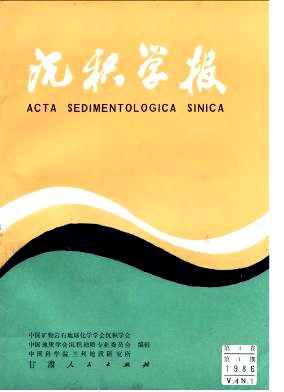A STUDY ON A ALGAE PIGMENT IN SEDIMENTS
- Received Date: 1984-05-24
- Publish Date: 1986-03-10
Abstract: Natural organic pigments can be found in sediments, crude oil, coal bitumen, oil shales, etc. A new organic pigment has been discovered in Tertiary-Sinian carbonates and other strata. Obviously, it originates mainly from organisms. It is of practical and theoretical significance in petroleum geology. This paper deals with my study on six Cambrian and Sinian specimens. First, the specimens were observed and identified by means of scanning electron microscop and microscope. Second, the specimens were characte-rized by palaeontology. It has been discovered that the main organisms in the specimens are the lowest bluegreen algae. No other organisms were found. Then, the pigment was extracted from geological samples by means of chloroform. Its solution was evaporated to nearly dry material. Later, the organic pigment extract was dissolved in n-hexane and evaporated to a volume of l-2ml, which was separated by column chromatography into three fractions -paraffin hydrocarbon, aromatic hydrocarbon and non-hydrocarbon. The non-hydrocarbon fraction was further separated by using thin layer chromatography of silicon G. The purified pigment compound was identified and studied by using the following instruments and methods: 1. Pigment element analysis: The elememt analysis was performed on a Italian 1106 element analyser, and the results are as follows: C = 71.3%, O=8.30%, H=7.63%, N=12.73%. Their ratio is: C:H:O:N: = 11.43:14. 67:1:1.69. The experimental formula of pigment is C22 H28 O2 N2. 2. SEM/EDAS analysis of metal ion in pigment: Metal ion in pigment was detected on a SEM/EDAX-501B. The analysis was made with the following method. Pigment was coated on the sample analyser and then determined by using energy spectroscopy scanning from sodium of atomic number 11 to uranium of atomic number 92, but no metal ion was found. 3. Ultraviolet-visible spectrophotometry: The sample was scanned from 200nm to 700nm. No absorption was seen in the ultraviolet range. But there were two absorption peaks in the visible range, 490nm and 520nm. Two same absorption peaks were found in the visible rang by continuous wavelength scanning on the CS-910 Dual-wavelength TLC scanner. 4. Fluorescent spectrophotometry: Since the red pigment has no ultraviolet absorption peaks because of the absence of its characteristic absorption in the ultraviolet range, there are also no characteristic fluorescence absorption peaks. 5. Gas chromatography: The pigment was analyzed by using 103 Gas Chromatography equipped with standard flame ionization detector (FID). The conditions are : glass capillary column, 47m length, 0.25 mm i.d. stationary phase MPPS. The temperature was programmed from 86℃ to 330℃ with 6℃/min. The peak didn't appear till 328℃. The analysis showed that the pigment was further purified after using TLC separation. 6. Mass spectrometric identification: The mass spectra were obtained on a D-300 mass spectrometer equipped with a solid sample probe. Samples were directly put in by a solid probe. The mass spectra showed that the main peaks were m/e 367 and 275. Based on these data, the author proposed a possible structure of the pigment. 7. ET-IR spectrophotometry identification: The result of ET-IR spectrum showed that the pigment had the following functional groups: the peak at 1708.9cm~(-1) representing carbonyl groups, the peaks at 2924.1cm~(-1), 1377.2 cm~(-1), and 2854.6cm~(-1), 1458.2cm~(-1) representing methyl and methylene respectively; and 3200cm~(-1) - 3600~(-1) absorption range indicating the occurrence ofNH group. 8. Nuclear magnetic resonance:Nuclear magnetic resonance spectra were recorded at 90 MHZ. CDCL3 was used as solvent with TMS internal reference. The nuclear magnetic resonance spectra showed the occurrence of RCH3, RCH2, NH, etc. The author believes that the pigment might originate from algae. Based on the above information and results, the author proposes the structure of the pigment for discussion. The paper covers in some details the reason of the pigment structure and its possible precursor, as well as theorigin of this pigment. Finally,the analyticity data of twelve core samples from a basin in China are listed showing the variation of the content of this pigment with depth,and its application to the petroleum exploration is discussed as follows:This pigment compound may be used as an index to identify the origin of organize matters,the type of source materials and the diagenetic environment of organic matters,and it can also be used to reflect the maturity and evolutional level of organic matters.
| Citation: | Xu Lian. A STUDY ON A ALGAE PIGMENT IN SEDIMENTS[J]. Acta Sedimentologica Sinica, 1986, 4(1): 20-33. |






 DownLoad:
DownLoad: